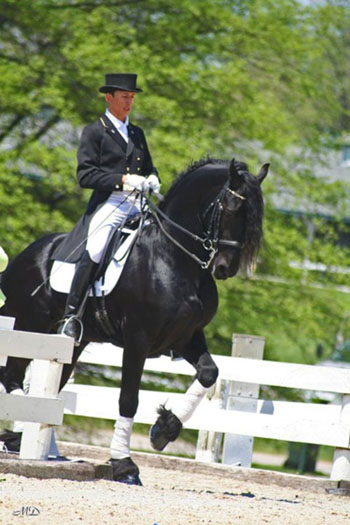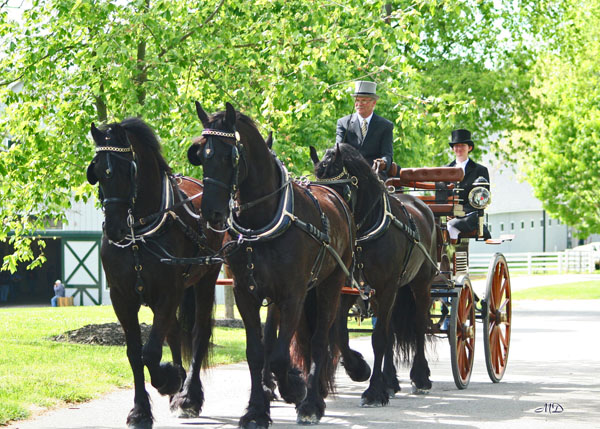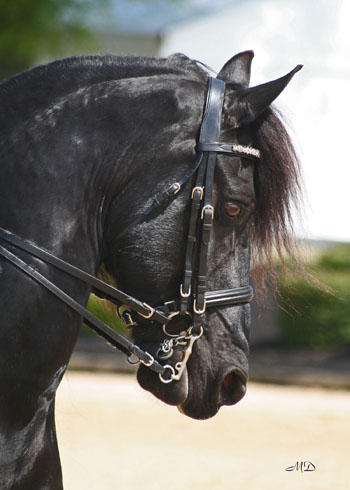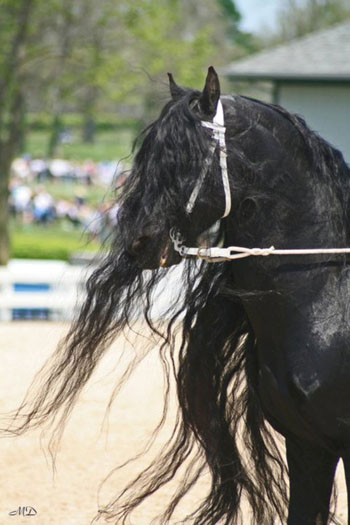Friesian Horse Breed Profile
Can you recognize a Friesian horse? This horse breed stands out with its shiny black coat and long, thick mane and tail. Equitrekking interviews Elizabeth Sharp, president of the Friesian Horse Association of North America (FHANA), to learn more about these graceful and striking horses.

All photos credited to Megan DeHart.
Equitrekking: What are the origins of the Friesian horse?
Elizabeth Sharp: The origins of the Friesian horse are the Northern-most province of Friesland in the Netherlands. Descended from the "Equus Robustus", of Europe, the breed originated there, with documentation starting in 1251, and regularly documented from then on throughout the early centuries. The breed has been selectively cultivated there, on and off ever since.
Equitrekking: What are the general conformation characteristics of Friesian horses?
Elizabeth Sharp: The Friesian horse is larger than the average horse with a very upright neck set, substantial bone, thick luxurious mane and tail, and of course the color is always black.

Equitrekking: How have Friesians been used and ridden throughout history?
Elizabeth Sharp: Friesians started out as the mounts for knights or noblemen, and were called "destrier", carrying knights into battles, tournaments and jousts.
When that use ended, they looked to the farmers who used them to do farm work and would clean them up and use them to pull the family carriage to church on Sundays.
Some breeders also bred a lighter, more refined horse for trotting races, popular in Europe and the Netherlands in the 1700 and 1800's. After the world wars, the breed came close to extinction. It was saved by a dedicated group of breeders, who in recent years have used the breed to all disciplines of riding and driving.

Equitrekking: What are some fun facts people may not know about Friesians?
Elizabeth Sharp: Friesian horses are always all black. They are the "Black Beauty" of little girls dreams.
They typically love water, and will play in it with wild abandon.
The Studbook was opened in May 1, 1879 to keep track of the breeding of purebred Friesian horses and has been in continuous use since then.
Friesian horses were one of the first horses to make use of the frozen semen technology and extensively use chilled or frozen semen to breed worldwide.
The KFPS, Royal Friesian Studbook, has some of the strictest registration requirements for all horses, but especially the handful of Approved registered Stallions, who undergo some of the strictest requirements in the world.
Equitrekking: What is the general temperament for which the breed is best known?
Elizabeth Sharp: The general temperament of the Friesian horse is very good. I think because of the regional breeding done with the horse, and the close association with the horses in Friesland, a good temperament is something that is desirable and bred to. The horse has to be able to be handled by all family members, so a fractious temperament is not at all desirable.
Equitrekking: What style of rider best suits the Friesian horse?
Elizabeth Sharp: All types of riders–– pleasure, sport, dressage, trail, and drivers–– they all suit the Friesian breed and temperament.

Equitrekking: How have Friesians evolved over time?
Elizabeth Sharp: They have evolved from a war horse, to a farm worker, to one of the most elite, and beautifully bred horses in the world, suitable for all styles of riding and driving.
Equitrekking: Please share with us some famous historical Friesian horses.
Elizabeth Sharp: Some of the "founding fathers of the breed" would have to be Tetman 205, Age 168, and Ritske 202P. These are the horses that made the cut into the studbook, when the outside breeding was stopped and they wanted to set the breed type. All Friesians can trace their lineage back to these horses.
Equitrekking: What makes the Friesian horse unique as a breed?
Elizabeth Sharp: The black color, the hair, which is thick and luxurious, the lovely temperament, upright neck carriage and gaited trot set the Friesian apart from other breeds.

Equitrekking: What are further resources for people interested in this breed?
Elizabeth Sharp: For more information on this lovely breed, visit the FHANA website, FHANA.com. The website is extensive and a great source of reference. We have information, breeding standards, all rules and regulations, as well as access to webinars on a wide variety of topics. There are breeders listed in all states, and our office staff will always answer questions. Also, check out the Mother Studbook, KFPS.nl, which has a wonderful wealth of information.





